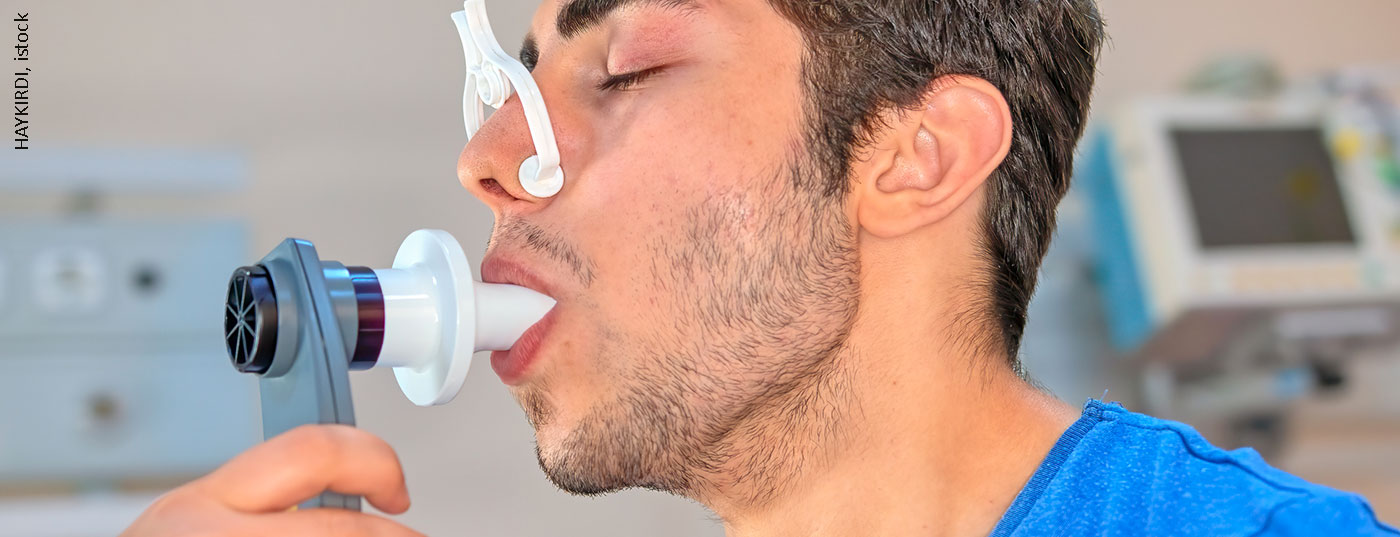When treating asthma patients, many thoughts run through the physician’s mind – after all, on the one hand he usually has several therapy options, but on the other hand he must also adapt to his patient’s sensitivities, for example when the patient sometimes accepts taking his medication as a friendly recommendation, but lacks adherence.
The challenges in the therapy of people with moderate asthma are manifold for physicians: they range from overcoming the discrepancy that can arise between physician and patient when setting goals (the more medication, the more likely freedom from symptoms vs. “I would prefer not to take any medication at all”), to recording asthma control (because in conversation, most patients claim they are fine – how long should the conversation be to get to the bottom of the truth?), to differentiating difficult vs. severe asthma and comorbid COPD. And the correct use of inhalation devices is an issue in itself for many asthmatics!
Dr. Justus de Zeeuw, a specialist in pulmonary and bronchial medicine from Cologne (D), presented a 30-year-old female patient with moderate asthma at the Interactive Case Seminar [1]. She works in retail and has a part-time job in a pub. The woman has had asthma since childhood and polyvalent allergic sensitization to various pollens. She also smokes 7-8 cigarettes a day. She suffers from coughing at night as well as during the day when the air is cold, which is an additional burden as she has to be in cold storage at times during her work. The patient walks her boyfriend’s dog from time to time (no animal allergy!), but is currently not interested in sports because she notices that she very quickly reaches her limit with shortness of breath.
Severe obstruction despite high-dose therapy
Current therapy consists of salmeterol/fluticasone (50/500 μg) in the morning and evening and salbutamol 100 μg DA as needed, which was 8 to 10 times a day at the time of presentation. Pulmonary function testing showed severe obstruction with severe discrepancy between the normal curve and the actual curve. FEV1 was reduced to 48%, and there was also significant hyperinflation to 252%. The expert was thus faced with the question of why the finding could be so pronounced even though the woman was already on a relatively high-dose medication. The answer was found in the lack of adherence, which the woman also admitted unreservedly: although she took the salmeterol/fluticasone combination, she did so only irregularly. And although she noticed that taking it was helping her, it kept wearing off as soon as it got a little better.
Her eosinophil count was 170/ml (2%), and total IgE was 253 kU/l. In view of this uncontrolled asthma and the data, Dr. de Zeeuw put the question to the plenary session what consequences colleagues would draw from such a laboratory finding. 16% of those participating in the online poll saw no approach to biologics therapy. Understandable from Dr. de Zeeuw’s point of view: “For me, the Eos are also too low; I wouldn’t have done anything in that direction either.”
About the same number of physicians voted for anti-IL-5 or -IL-5R; the expert sees this as an option under certain conditions: “Looking at the eosinophils, you can say that if she had had an oral steroid at the time, e.g., prednisolone continuous therapy, then you could talk about it.” For anti-IL-4/anti-IL-13 (7%), it would still be necessary to determine the FeNo value. Anti-IgE, on the other hand, favored by 27% of the participants, could not be recommended by the pulmonologist because he lacked the house dust mite for it. “With seasonal allergens, there are studies that you can do that, but in practice, I’m bound by approved indications, and the patient didn’t have those in this case.”
LAMA good option, but fingers off theophylline
Dr. de Zeeuw initially decided to motivate the patient to stop smoking, also addressed the lack of adherence and recommended rehabilitation. In addition, the woman was vaccinated against influenza and pneumococcus. With regard to further drug treatment, there were several options: According to the pneumologist, a cortisone shot would definitely be worth considering, e.g., in order to see how much is “still open upwards” in the patient during several days of prednisolone administration. He recalled the GOAL trial, which did just that, 14 days of prednisolone on top of ICS/LABA at maximum dose with persistent obstruction. However, GOAL has shown that – with optimal adherence – there is little change in this regard. Nevertheless, Dr. de Zeeuw might be comfortable with it, if only as an “adherence test” for his patient. However, he strongly advised against the additional administration of theophylline: this could have life-threatening consequences for patients!
Regarding montelukast, the pulmonologist referred to the MONICA study. There, montelukast was given on top in addition to ICS with the result that asthma control improved. “However, MONICA suffers from the fact that no one asked beforehand whether patients were taking their ICS at all,” Dr. de Zeeuw noted. Given the severity of the obstruction, the doctor expected too little from montelukast to seriously consider it as an option: “If someone has normal lung function and gets allergy-related problems, it’s perfectly okay to give them montelukast for 20 days during allergy season. But with obstruction as severe as this, I don’t think there would be a noticeable effect.”
Dr. de Zeeuw ultimately decided to give his patient an additional LAMA (tiotropium 2.5 μg Respimat) to the ICS/LABA combination. Also an option for him would have been to switch the ICS/LABA combo. “Because of the lack of adherence, I didn’t want to send the patient home with the feeling that she had done something wrong, so I left her on her old combo so as not to change too much at once.” At the follow-up 4 weeks later, the patient already presented with significantly improved values under the triple salmeterol/fluticasone/tiotropium: FEV1 had increased to 69%-without cortisone, the physician pointed out-and hyperinflation was reduced from 250% to 188%. The woman subjectively felt a very big difference, she rarely needed the salbutamol anymore. She had reduced the number of cigarettes to 3-4 per day at this point and was motivated to quit smoking altogether because of the noticeable sense of accomplishment.
Dr. de Zeeuw concluded by calling this case a success story, but one that also exemplifies the pros and cons that physicians must weigh when treating people with asthma.
Source:
- StreamedUp: PneumoLive – Interactive Case Seminar, 10/27/2020.
InFo PNEUMOLOGY & ALLERGOLOGY 2021; 3(1): 25.











